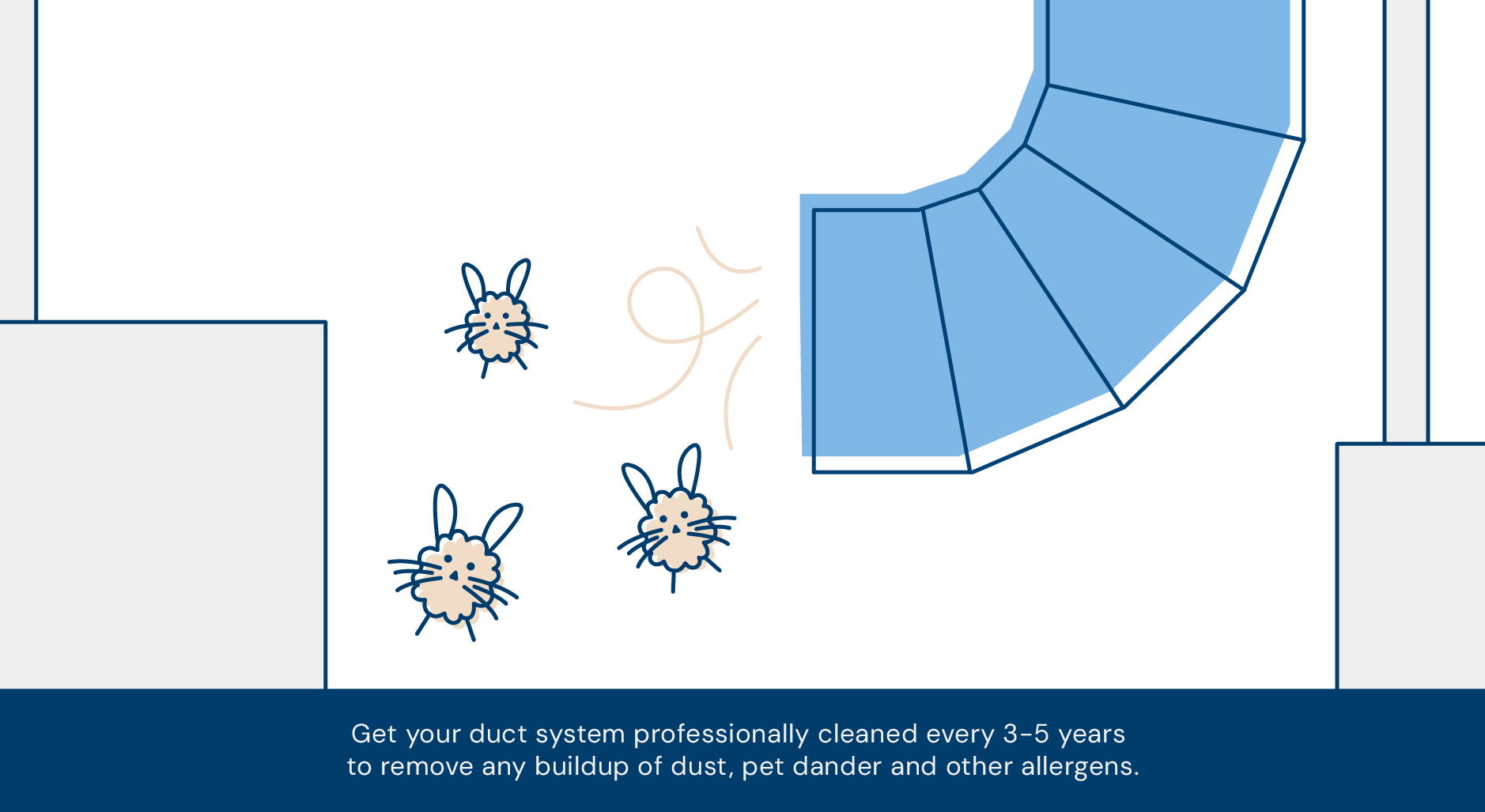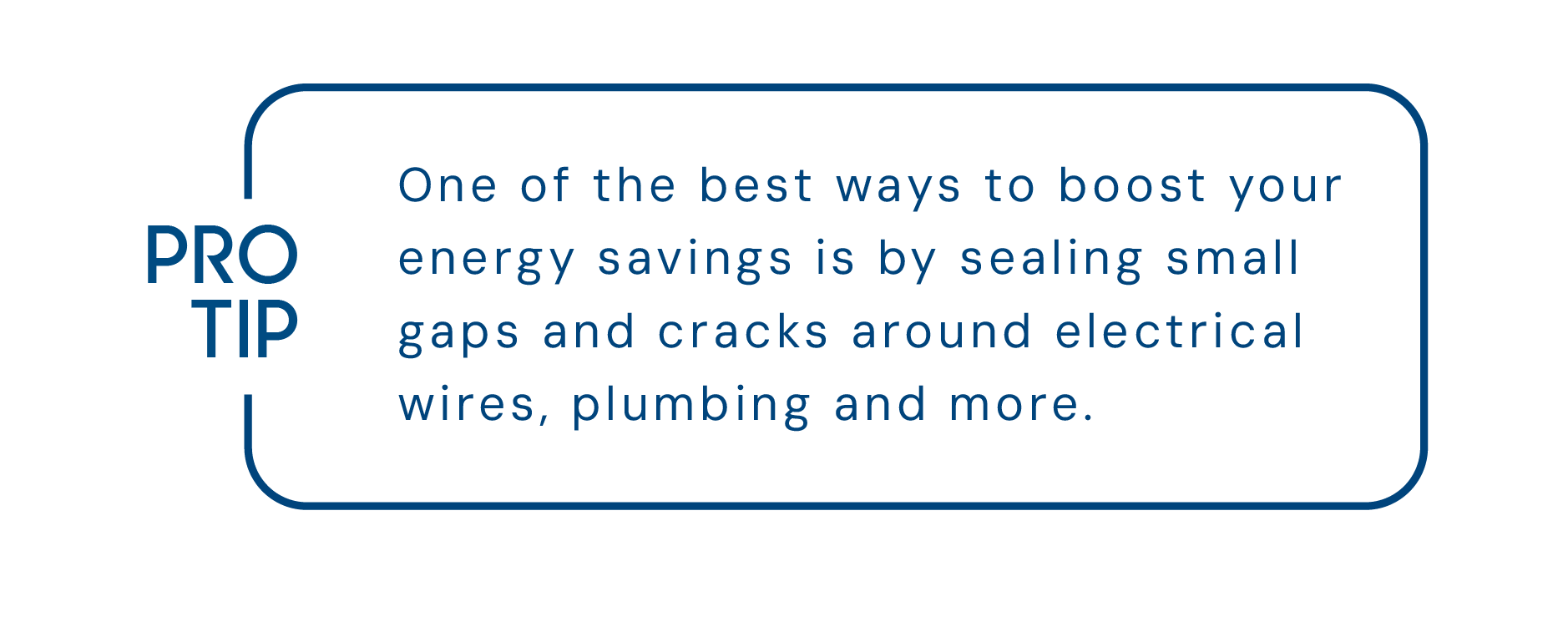26 ways to improve your home’s indoor air quality (and save some $$)

Did you know that, on average, Americans spend a whopping 90% of their time indoors, and that the concentrations of some pollutants may be up to five times higher indoors than outdoors?¹ Both short- and long-term exposure to indoor air pollution can lead to health issues like headaches, fatigue, respiratory diseases, heart disease, cognitive deficits and cancer.²
Ready for some good news? Take a deep breath: Healthy indoor air quality has been associated with enhanced cognitive performance, better decision-making and increased productivity.³ That’s more like it. But how do you know if your home’s indoor air quality could be improved? How do you improve it? And what’s indoor air quality have to do with saving energy and lowering your energy bill? So many questions, and we’ve got answers! Let’s get started.
What makes indoor air unhealthy?
Contaminants such as allergens, carbon monoxide, chemicals, radon, smoke and mold all contribute to poor indoor air quality. There are plenty of potential polluters, too, such as gas ovens and ranges, wood-burning fireplaces, cleaning solutions, chemicals used in certain paints and furnishings, outdated heating and air conditioning systems, damp basements, animal dander and dirty ventilation systems.⁴ And yes, this list also includes dust mites and cockroach droppings.
Things that can contribute to unhealthy indoor air.
Those issues we just mentioned — headaches, fatigue, trouble breathing, etc. — can all be signs and symptoms of unhealthy indoor air. If you’re not quite sure about the quality of your home’s air, though, take a look at this list of things that could be affecting your indoor air quality:
- Humidity regularly above 50%
- Visible mold or mildew
- The smell of mold or mildew
- Standing water or excess moisture
- Air fresheners designed to mask odors
- Perfumes and other fragranced products
- New or additional cleaning products
- Presence of smoking or vaping
- Indoor pets
- Chemicals, paints or solvents stored inside
- Recent pesticide use
- Outside vehicle exhaust or dust
- Fuel-burning appliances (gas stoves, water heaters, fireplaces)
- Blocked air vents
- An aging or infrequently maintained HVAC system
- Cracks, gaps or holes around windows and doors, and in ductwork
What you think you know about pet allergies is probably wrong.
In many households the pet dog or cat is as much a part of the family as everyone else, so let’s spend a little extra time talking about our four-legged friends. Not all human family members can tolerate furry friends as easily as others. Why? If you guessed it’s because of their fur, try again. It actually isn’t our pets’ fuzzy exteriors that give allergy sufferers such a hard time. It’s an allergen found in their saliva and dander (dead skin flakes), or in the case of pocket pets (like guinea pigs, hamsters and rabbits), their urine.
But what about hypoallergenic dogs or those hairless cats? No animal is truly “hypoallergenic,” despite what the Internet or a breeder may tell you. When animals shed, whether it’s their skin or fur, urinate, defecate or even just give you a big, sloppy kiss, invisible-to-the-naked-eye proteins are released, causing an allergic reaction.
This doesn’t mean you can’t own a furry pet, though. It just means taking extra steps to boost your home’s indoor air quality so that those flying proteins don’t find a home inside your lungs. Fortunately, the recipe for cleaner, healthier indoor air — whether you’re dealing with pet dander or a damp basement — is simple: adequate ventilation and controls for pollution, temperature and humidity levels.

How to improve air quality at home … and even save some money.
Now it’s time for the fun stuff — how to actually improve your home’s indoor air quality so that you can breathe better and lower your energy bill by using less energy.
Minimize pollutants.
It might sound overly simplistic, but one of the easiest ways to improve air quality is to reduce or eliminate indoor pollutants like carbon monoxide, radon or harsh chemical cleaning products. Try these tactics for decreasing your exposure to indoor pollutants and contaminants:
1. Prevent carbon monoxide leaks by getting your gas appliances, chimneys, and fireplaces or wood stoves checked annually by a professional. Carbon monoxide is a poisonous, odorless and lethal gas that can build up quickly indoors.
2. Invest in a carbon monoxide detector. Search our EnergyRight Marketplace to explore models ranging from around $15 to $200.
3. Get your home checked for radon, a natural radioactive gas that can build up in your home! According to the Tennessee Department of Environment and Conservation (TDEC), radon is a very serious problem in the state.⁵
4. Avoid cleaning products that contain harmful chemicals and fumes that can linger in the air; glass cleaners, bleach, air fresheners and cleaning sprays are common culprits.
5. Switch to non-toxic cleaning products, or make your own for a green, cost-effective clean.
6. Buy an air purifier. Quality, energy efficient models, starting around $150, can capture 99.97% of allergens and particulates and 99.9% of viruses and bacteria in spaces measuring about 350 square feet or less.
7. Make friends with your vacuum cleaner. Rugs, carpets, upholstered furniture, pillows and mattresses love to trap dust, debris, dander and more. They’re also a haven for dust mites.
8. Purchase a dehumidifier. The ideal indoor humidity range is 30% to 50%. The more humidity you have inside your home, the greater the chance for excess moisture, mold and mildew, which can make you very sick, especially with prolonged exposure. If you’re not sure what your humidity level is, you can buy an inexpensive hygrometer for about $10.

Maintain your HVAC system.
Your heating and cooling system accounts for the majority of your home’s monthly energy use (upwards of 50%!), not to mention it’s one of the most expensive components of any home. So, if there’s one area of your home to really stay on top of maintenance, it’s your HVAC system. You’ll get more life out of it, and proper maintenance is going to ensure better indoor air quality and better energy efficiency. Here’s what to do:
9. Change your air filter monthly, or at least once a quarter, to trap dust, dirt and airborne particulates.
10. Get an HVAC tune-up twice a year, once in the spring and once in the fall, to identify and fix any issues.
11. Schedule reminders in your calendar to change your air filter and schedule tune-ups.
12. Use one of our TVA-vetted Quality Contractor Network members to complete your tune-up (electric systems only) and receive a $50 rebate.

Upgrade your HVAC system.
The average lifespan of an HVAC system is 15-20 years, over which time its energy efficiency will decrease. So, if you’re approaching the end of your unit’s functional lifespan, investing in a new one is an excellent way to improve air quality and lower energy costs.
It’s important to remember, too, that your AC doesn’t just cool your home, but it also pulls humidity from the air inside for greater indoor comfort. The size of your home determines what kind of system you need to ensure proper cooling and humidity control. It’s not unusual for customers to have HVAC systems that are incompatible with home size. Work with a professional to make sure your HVAC upgrade is right for your home and your budget.
That being said, we know a new HVAC system comes with a hefty price tag. So, TVA EnergyRight wants to make it easier for you to lower or better manage the cost of this energy-saving upgrade. Here’s how:
13. Explore our wide range of HVAC system rebates worth up to $1,500.
14. See if you qualify for $0 down, fixed-interest-rate financing.
15. Find out if you’re eligible for Home Uplift, a program we offer in partnership with local power companies to provide up to $10,000 of home energy upgrades to income-qualified participants. (Not available at all local power companies in the TVA region.)
Get your ducts in a row.
The kid sister to your HVAC system, your ductwork plays an integral role in the quality of your indoor air. Excellent ventilation reduces the concentration of indoor pollutants. Like your HVAC system, your duct system needs to be maintained, too, for optimal performance. By taking care of your ductwork, you ensure its longevity and the performance of your HVAC system, improve the quality of your indoor air, and can lower your energy bill. Here’s how:
16. Install an externally vented exhaust fan in your kitchen and bathrooms to reduce moisture and odors. (Don’t forget to run and clean your exhaust fans, too, so that they’re not accumulating irritating dust.)
17. Get your duct system professionally cleaned to keep clean air flowing, seal cracks or holes in ductwork and increase the efficiency of your HVAC system. Pro tip: Ask for the before and after photos. The dust buildup can be jaw-dropping!
18. Keep your air vents open. Shutting or blocking an air vent in one room to “force” cold or hot air into another doesn’t work. All it does is force your HVAC system to work harder and put unnecessary pressure on your ductwork.
19. Uncover any blocked air vents. If any vents in your home are covered by furniture, drapes or rugs, you’re forcing your duct system and HVAC system to work harder. Over time, that’s going to decrease the lifespan of those systems and drive up your energy bill.
20. Use our $300 duct system rebate to seal, repair, insulate or replace ductwork.

Air seal your home.
A few gaps and cracks around your home may seem insignificant, but the truth is, all those small spaces add up. All together, they’re equivalent to leaving a window open all year long, which is definitely not good for your energy bill and creates a lot of ways for allergens to sneak in.
Spots near windows and doors may be the easiest to see, but don’t forget about holes hidden in attics, basements and crawl spaces, along with penetrations in ceilings and floors for electrical wires, plumbing, ducts, chimneys, flue pipes and recessed lights. A little-known fact: Sealing these hidden spots in the upper and lower areas of your home is often the greatest opportunity for energy savings.

21. Do DIY weatherization. With a caulk gun, some caulk and a little free time, you can seal up any cracks you find around your windows, inside or outside. Pick up inexpensive weatherstripping or expanding foam to fill in larger gaps around windows and doors, and lay a door sweep at the bottom of any drafty doors. (Dealing with asthma or allergies? Check out these helpful tips.)
22. Use our $300 rebate toward the professional air sealing of your entire home.
Replace your attic insulation.
Out of sight, out of mind, right? Wrong. Like your duct system, your attic insulation is one of those things that most people forget to consider, especially when it comes to its role in improving indoor air quality. But when you think about it, what better place for all sorts of contaminants to linger than deep in the cushy pink fluff that is your attic insulation (or at least some people’s attic insulation).
When you replace your attic insulation, not only are you removing irritants and allergens, you’re also improving your home’s energy efficiency. A well-insulated attic keeps your home cool in the summer and warm in the winter, saving you money on your monthly heating and cooling bill.
23. Install blow-in insulation. Technically called blow-in cellulose, this type of insulation is made of either fiberglass or recycled materials and is a cost-effective way to reinsulate your attic after you’ve ripped out the old materials.
24. Opt for polyurethane foam spray. This form of insulation is made of antimicrobial foam and prevents moisture, air and animals from entering your home. It’s also very energy efficient, blocking summer sun from entering through the roof and blocking your heating from escaping through the roof in the winter.
25. Use our limited-time-only $500 rebate toward the professional installation of new attic insulation.
Purify with photosynthesis.
Science alert! How do plants purify the air? During photosynthesis, plants convert carbon dioxide into fresh oxygen. Now you can beautify your home and purify your indoor air at the same time.
26. Treat yourself to a plant or two and infuse a breath of fresh air into your home. Try a snake plant, aloe vera, pothos, fiddle-leaf fig or spider plant to start.
Breathe better and get a better energy bill with help from TVA EnergyRight.
Everyone deserves to breathe clean air, especially inside their own home. TVA EnergyRight’s energy-saving and money-saving programs help increase your indoor comfort and air quality. Check out all our home energy rebates so you can save money and breathe easier at EnergyRight.com/Rebates.
Discover more than $3,000 in home energy rebates.

¹ U.S. Environmental Protection Agency. 2023. “What Are the Trends in Indoor Air Quality and Their Effects on Human Health.” https://www.epa.gov/report-environment/indoor-air-quality#note1.
² National Institute of Environmental Health Sciences. 2023. “Indoor Air Quality.” https://www.niehs.nih.gov/health/topics/agents/indoor-air/index.cfm.
³ American Industrial Hygiene Association. 2020. “The Value of IAQ: A review of the scientific evidence supporting the benefits of investing in better indoor air quality.” https://www.researchgate.net/publication/353719205_The_Value_of_IAQ_A_review_of_the_scientific_evidence_supporting_the_benefits_of_investing_in_better_indoor_air_quality.
⁴ U.S. Environmental Protection Agency. 2023. “Care for Your Air: A Guide to Indoor Air Quality.” https://www.epa.gov/indoor-air-quality-iaq/care-your-air-guide-indoor-air-quality.
⁵ TN Department of Health. 2023. “Healthy Homes – Radon.” https://www.tn.gov/health/cedep/environmental/healthy-homes/hh/radon.html.




